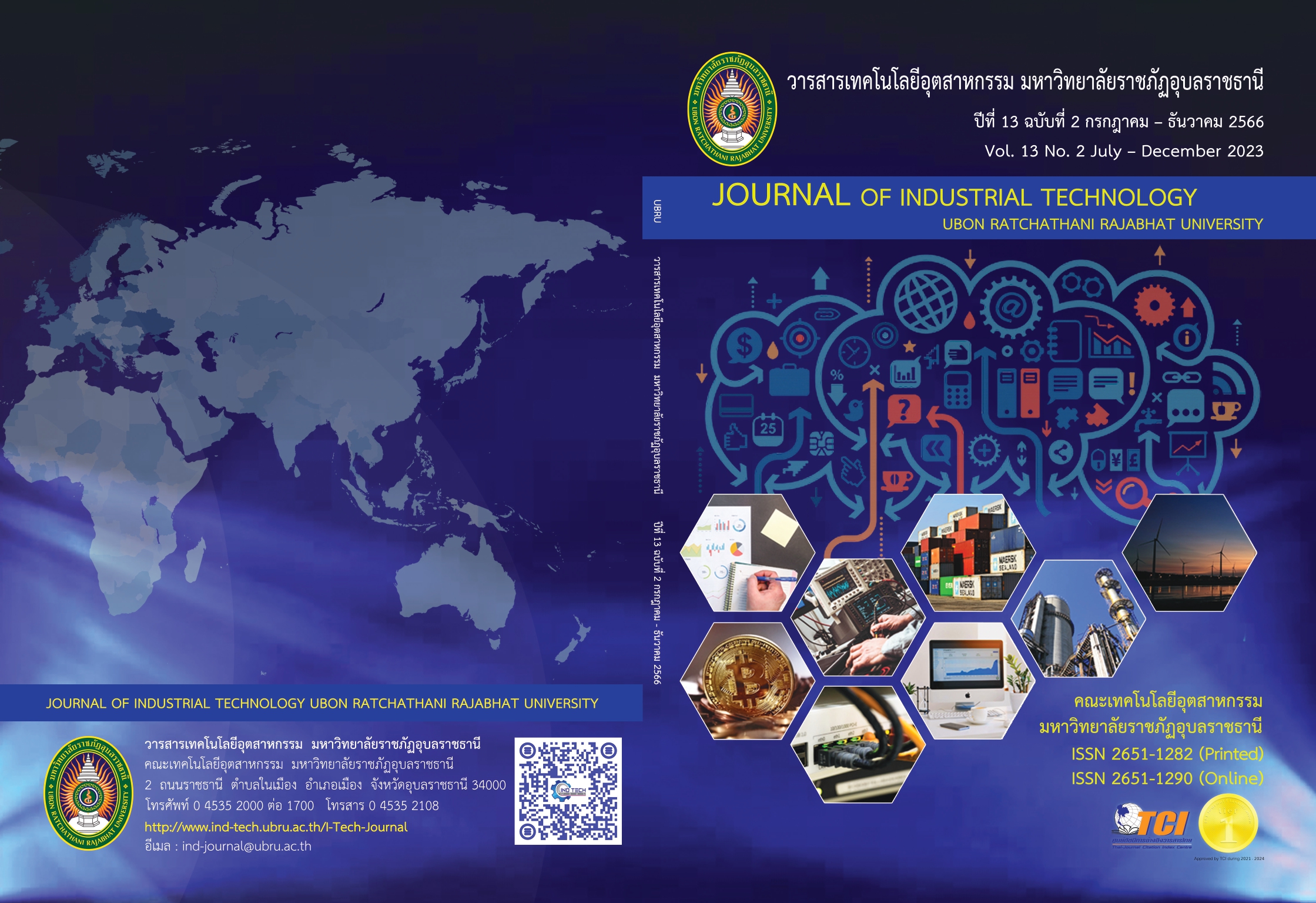การอบแห้งสมุนไพรดีปลีที่อุณหภูมิและความชื้นสัมพัทธ์ต่ำ
Main Article Content
บทคัดย่อ
งานวิจัยนี้มีวัตถุประสงค์เพื่อหาปัจจัยที่ส่งผลต่อการอบแห้งสมุนไพรดีปลี และเพื่อหาแบบจำลองทางคณิตศาสตร์ที่เหมาะสมกับการอบแห้งสมุนไพรดีปลีที่อุณหภูมิและความชื้นสัมพัทธ์ต่ำ โดยอบแห้งสมุนไพรดีปลีด้วยอากาศจากเครื่องควบคุมอากาศที่พัฒนามาจากเครื่องปรับอากาศในอาคารทำงานร่วมกับขดลวดทำความร้อน
ผลการทดลอง พบว่า ความชื้นสัมพัทธ์ของอากาศเป็นปัจจัยที่ส่งผลต่อเวลาการอบแห้ง เมื่อความชื้นสัมพันธ์ของอากาศเพิ่มขึ้นจาก 30 เปอร์เซ็นต์ เป็น 40 เปอร์เซ็นต์ และ 50 เปอร์เซ็นต์ ค่าเวลาการอบแห้งจะเพิ่มขึ้นจาก 74 ชั่วโมง เป็น 105 ชั่วโมง และ 113 ชั่วโมง ตามลำดับ และส่งผลต่อค่าสัมประสิทธิ์การแพร่ความชื้นของสมุนไพรดีปลี เมื่อความชื้นสัมพัทธ์ของอากาศเพิ่มขึ้น ค่าสัมประสิทธิ์การแพร่ความชื้นของสมุนไพรดีปลีจะลดลง มีค่าการทดลองดีที่สุด คือ ที่ความชื้นสัมพัทธ์ของอากาศ 30 เปอร์เซ็นต์ โดยใช้เวลาในการอบแห้งน้อยที่สุด 74 ชั่วโมง มีค่าอัตราการอบแห้งสูงสุดเท่ากับ 0.13 ต่อชั่วโมง ซึ่งเกิดขึ้นในช่วงเริ่มต้นของการทดลองและมีค่าสัมประสิทธิ์การแพร่ความชื้นสูงสุดเท่ากับ 11.156264×10-12 ตารางเมตรต่อวินาที แบบจำลองทางคณิตศาสตร์ที่เหมาะสมที่สุดสำหรับการอบแห้งที่อุณหภูมิและความชื้นสัมพัทธ์ต่ำ คือ แบบจำลองเฮนเดอร์สันและพาบิส 2 เทอม การหาค่านอกช่วงการทดลองโดยแบบจำลองพบว่า การลดความชื้นให้ต่ำลง ค่าเวลาการอบแห้งจะต่ำลงเช่นเดียวกัน และส่งผลให้ค่าความสิ้นเปลืองพลังงานเพิ่มขึ้น ดังนั้นถ้าพิจารณาจากความสิ้นเปลืองพลังงาน พบว่า ปัจจัยความชื้นสัมพัทธ์ของอากาศ 35 เปอร์เซ็นต์ เป็นตัวเลือกที่เหมาะสมที่สุด เพราะมีความสิ้นเปลืองพลังงานน้อยสุด 32.5 กิโลวัตต์-ชั่วโมง นอกจากนั้นยังพบว่าการอบแห้งแบบแสงอาทิตย์จะมีปริมาณเชื้อรามากกว่าการอบแห้งแบบอุณหภูมิความชื้นสัมพัทธ์ต่ำถึง 7.99×103 โคโลนีต่อกรัม
Article Details

อนุญาตภายใต้เงื่อนไข Creative Commons Attribution-NonCommercial-NoDerivatives 4.0 International License.
บทความที่ได้รับการตีพิมพ์ในวารสารฯ ท้ังในรูปแบบของรูปเล่มและอิเล็กทรอนิกส์เป็นลิขสิทธิ์ของวารสารฯ
เอกสารอ้างอิง
Khedari J, Sangprajak A and Hirunlab J. Thailand climatic zones. Renewable Energy. 2002; 25: 267–80.
Prakash Q and Kumar A. Solar drying technology: concept, design, testing, modeling, economics, and environment: Springer; 2017.
Barbosa-Cánovas G V, Fontana A J, Schmidt S J and Labuza T P. Water activity in foods: fundamentals and applications. John Wiley & Sons. 2020.
Arundel A V, Sterling A M, Biggin J H, and Sterling T D. Indirect health effects of relative humidity in indoor environments. Environmental health perspectives. 1986; 65: 351-61.
Aritiaya P and Amornchai A. Drying Technology. Technology Promotion Association (Thailand-Japan). 2014; 41: 234 (in Thai)
Zlatanovic I, Komatina M, and Antonijevic D. Low-temperature convective drying of apple
cubes. Applied Thermal Engineering. 2013; 53: 114-23.
Ondier G O, Siebenmorgen T J and Mauromoustakos A. Low-temperature, low-relative humidity drying of rough rice. Journal of Food Engineering. 2010; 100: 545-50.
Sosle V, Raghavan G, and Kittler R. Low-temperature drying using a versatile heat pump dehumidifier. Drying Technology. 2003; 21: 539-54.
Nagaya K, Li Y, Jin Z, Fukumuro M, Ando Y, and Akaishi A. Low-temperature desiccant-based food drying system with airflow and temperature control. Journal of food engineering. 2006;
: 71-7.
Arundel A V, Sterling A M, Biggin J H, and Sterling T D. Indirect health effects of relative humidity in indoor environments. Environmental health perspectives. 1986; 65: 351-61.
Zlatanovic I, Komatina M, and Antonijevic D. Low-temperature convective drying of apple
cubes. Applied Thermal Engineering. 2013; 53: 114-23.
Serm J. Solar Drying Technology [Internet]. 2560 [cited 2020 December 19] availablefrom:
http://www.phy.sc.su.ac.th/book/SolarDrying2017.pdf (in Thai)
Crank, J. (1975). The Mathematics of Diffusion. Clarendon Press, Oxford.. (1975); 2: 413
Zlatanovic I, Komatina M, and Antonijevic D. Low-temperature convective drying of apple
cubes. Applied Thermal Engineering. 2013; 53: 114-23.


